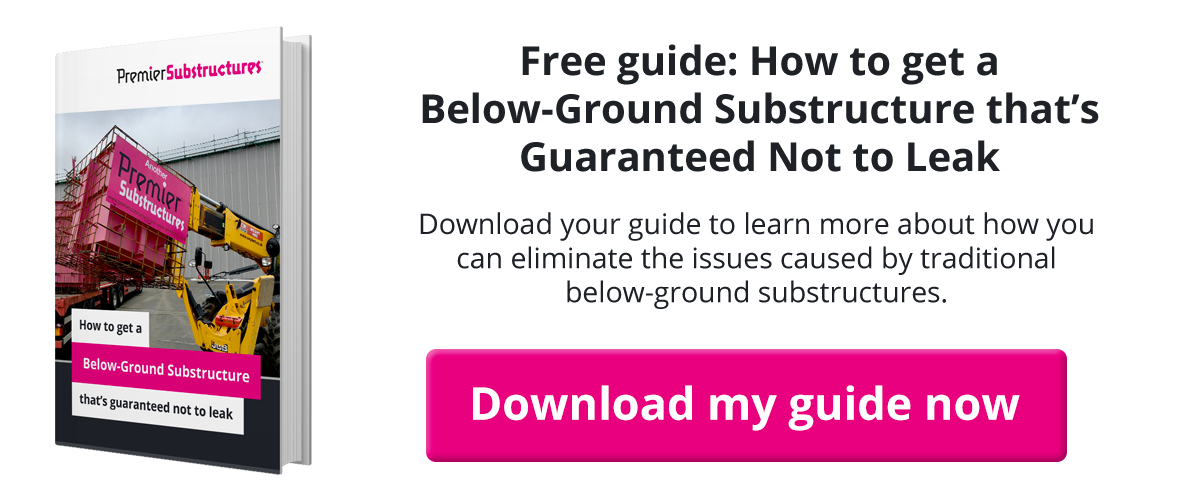Wondering if yours is the fastest below-ground construction method, or if there’s something better out there?
If you’re tired of how long in situ and precast concrete methods take, or if you’ve had problems in the past with projects running over, you may be open to exploring new options.
What if I told you that you could actually save up to 70 – 80% of time spent on-site?
As a specialist subcontractor, I’m going to talk you through your main options, and introduce a lesser-known but faster way of constructing below-ground: prefabricated steel substructures.
You may already have a question; I can see it coming. So…
What are prefabricated steel substructures?
Prefabricated steel substructures are a different approach to below-ground construction. They’re manufactured entirely out of steel in an off-site factory environment. Afterwards they’re transported to the site, fixed into position, and then back-filled with concrete between the earth and the steel substructure.
Not everyone’s familiar with this method, but it’s been around for over 35 years. It’s an innovative way of constructing below-ground that entirely eliminates the risk of leaks, making it a great option, particularly for areas with high water tables. It can also be built to very high tolerances of (+-3mm/4mm).
But the best thing about prefabricated steel substructures? It saves you time on-site. So, what’d usually take weeks if not months to complete, could be done in just a matter of days.
Now, let’s compare prefabricated steel to your other main options when constructing below-ground.
Your three main below-ground construction options, compared
If you’ve been constructing below-ground for a while, you’re probably already familiar with the methods of in situ and precast concrete. Below, I’m going to go over how long each of these typically takes on-site, and how prefabricated steel compares.
For instance, let’s say you needed a 4m wide x 10m long x 1.5m deep below-ground substructure for your project. In good conditions, such as a stiff clay location, you’d be looking at:
- In situ concrete = 24 working days
- Precast concrete = 16 working days (assumed in situ slab construction)
- Prefabricated steel = 8 working days
As you can see, prefabricated steel greatly reduces your time on-site. However, there is a caveat to this, in that prefabricated steel substructures need more upfront time to be manufactured.
TIP: You can read more about installation times in my recent blog: ‘How Long Does it Take to Install a Prefabricated Steel Substructure?’.
How long does it take to manufacture prefabricated steel?
Because prefabricated steel is built off-site in a factory or off-site facility, it completely changes the way below-ground construction is done, and requires more time upfront. So, when it comes to delivery, your substructure is already constructed and ready to go.
This is in contrast to more traditional methods, which involve taking all the material to the site and building there – leading to much longer times spent on-site.
So, how long does it take upfront to manufacture prefabricated steel?
Well, you’d typically be looking at around six weeks’ lead time. This is broken down into two weeks for design, and then another four weeks for fabrication – this will vary, depending on the size and scale of the project.
The difference is, if your prefabricated steel substructure is specified upfront and ready to go, it’d be starting on the same day as in situ. You’d still be digging the hole on a specific date, only a prefabricated steel substructure will be ready to go, and installed in just a matter of days.
The trick is to pre-order, so that while you’re waiting to go on-site, your prefabricated steel substructure is in a factory being custom-built to your exact specifications.
Advice from a specialist subcontractor
If you’d like to save time spent on-site with a prefabricated steel substructure, my best advice is to engage with a subcontractor who specialises in prefabricated steel early on in the design and tender process. This will help you better understand the benefits and the methodology of how it needs to be installed.
A specialist subcontractor should also take the time to discuss with you the substructure’s final use, and whether anything else is needed (such as extra fittings or fixtures). They may also ask you if you understand the maintenance required for concrete substructures, as well as how this compares to prefabricated steel.
All of this information can then be filtered into the overall construction programme. An order can then be given to your chosen subcontractor, taking into account the design and manufacture lead time, so they can start working on the project before the lead time’s too long, and there’s a problem in incorporating prefabricated steel within the project’s duration.
Conclusion
I hope you’ve found this blog helpful when discovering the fastest below-ground construction method. We’ve compared all potential methods above.
Although prefabricated steel could technically save you up to 70 – 80% of time spent on-site, it’s a different way of working which requires plenty of time (around six weeks) to engage with a subcontractor in advance.
Do you have any questions about prefabricated steel and how it might be right for your project? Feel free to leave me a comment below – or alternatively, get in touch with me directly. I’d be happy to help!

